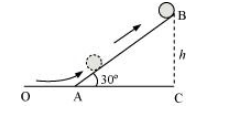A solid cylinder rolls up an inclined plane of angle of inclination $30^{\circ}$. At the bottom of the inclined plane the centre of mass of the cylinder has a speed of 5 $\mathrm{m} / \mathrm{s}$
(a) How far will the cylinder go up the plane?
(b) How long will it take to return to the bottom?
A solid cylinder rolling up an inclination is shown in the following figure.

Initial velocity of the solid cylinder, v = 5 m/s
Angle of inclination, $\theta=30^{\circ}$
Height reached by the cylinder $=h$
(a) Energy of the cylinder at point A:
$\mathrm{KE}_{\mathrm{rm}}=\mathrm{KE}_{\text {tans }}$
$\frac{1}{2} I \omega^{2}=\frac{1}{2} m v^{2}$
Energy of the cylinder at point $\mathrm{B}=m \mathrm{~g} h$
Using the law of conservation of energy, we can write:
$\frac{1}{2} I \omega^{2}=\frac{1}{2} m v^{2}=m \mathrm{~g} h$
Moment of inertia of the solid cylinder, $I=\frac{1}{2} m r^{2}$
$\therefore \frac{1}{2}\left(\frac{1}{2} m r^{2}\right) \omega^{2}+\frac{1}{2} m v^{2}=m \mathrm{~g} h$
$\frac{1}{4} m r^{2} \omega^{2}+\frac{1}{2} m v^{2}=m g h$
But we have the relation, $v=r \omega$
$\therefore \frac{1}{4} v^{2}+\frac{1}{2} v^{2}=\mathrm{gh}$
$\frac{3}{4} v^{2}=\mathrm{g} h$
$\therefore h=\frac{3}{4} \frac{v^{2}}{g}$
$\therefore h=\frac{3 v^{2}}{4} \frac{v}{g}$
$=\frac{3}{4} \times \frac{5 \times 5}{9.8}=1.91 \mathrm{~m}$
In $\triangle A B C$ :
$\sin \theta=\frac{\mathrm{BC}}{\mathrm{AB}}$
$\sin 30^{\circ}=\frac{h}{\mathrm{AB}}$
$\mathrm{AB}=\frac{1.91}{0.5}=3.82 \mathrm{~m}$
Hence, the cylinder will travel 3.82 m up the inclined plane.
(b) For radius of gyration K, the velocity of the cylinder at the instance when it rolls back to the bottom is given by the relation:
$v=\left(\frac{2 \mathrm{~g} h}{1+\frac{K^{2}}{R^{2}}}\right)^{\frac{1}{2}}$
$\therefore v=\left(\frac{2 \mathrm{~g} \mathrm{AB} \sin \theta}{1+\frac{K^{2}}{R^{2}}}\right)^{\frac{1}{2}}$
For the solid cylinder, $K^{2}=\frac{R^{2}}{2}$
$\therefore v=\left(\frac{2 \mathrm{~g} \mathrm{AB} \sin \theta}{1+\frac{1}{2}}\right)^{\frac{1}{2}}$
$=\left(\frac{4}{3} \mathrm{~g} \mathrm{AB} \sin \theta\right)^{\frac{1}{2}}$
The time taken to return to the bottom is:
$t=\frac{\mathrm{AB}}{v}$
$=\frac{A B}{\left(\frac{4}{3} g A B \sin \theta\right)^{\frac{1}{2}}}=\left(\frac{3 A B}{4 g \sin \theta}\right)^{\frac{1}{2}}$
$=\left(\frac{11.46}{19.6}\right)^{\frac{1}{2}}=0.764 \mathrm{~s}$
Therefore, the total time taken by the cylinder to return to the bottom is (2 × 0.764) 1.53 s.
Click here to get exam-ready with eSaral
For making your preparation journey smoother of JEE, NEET and Class 8 to 10, grab our app now.
